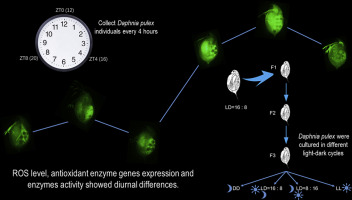当前位置:
X-MOL 学术
›
Comp. Biochem. Physiol. B Biochem. Mol. Biol.
›
论文详情
Our official English website, www.x-mol.net, welcomes your feedback! (Note: you will need to create a separate account there.)
Circadian rhythm regulation of the oxidation-antioxidant balance in Daphnia pulex.
Comparative Biochemistry and Physiology B: Biochemistry & Molecular Biology ( IF 2.2 ) Pub Date : 2019-11-14 , DOI: 10.1016/j.cbpb.2019.110387 Mingqi Cai 1 , Zhiquan Liu 1 , Ping Yu 1 , Yang Jiao 1 , Qiang Chen 1 , Qichen Jiang 2 , Yunlong Zhao 3
Comparative Biochemistry and Physiology B: Biochemistry & Molecular Biology ( IF 2.2 ) Pub Date : 2019-11-14 , DOI: 10.1016/j.cbpb.2019.110387 Mingqi Cai 1 , Zhiquan Liu 1 , Ping Yu 1 , Yang Jiao 1 , Qiang Chen 1 , Qichen Jiang 2 , Yunlong Zhao 3
Affiliation

|
Rhythmic changes in reactive oxygen species (ROS) levels with time have been previously reported, but circadian rhythmic changes in ROS levels in Daphnia pulex remain unexplored. Here, in light-dark (L/D 16:8, L/D 8:16), continuous light (LL), and continuous dark (DD) conditions were set up to analyze the accumulation of ROS and activity of antioxidant enzymes in D. pulex at different time points. We observed that ROS levels significantly varied from day to night. By fluorescence probe labeling, we noted that ROS majorly accumulated in the thoracic limbs, brood chamber, and rectum in D. pulex. In addition, in the L/D 16:8 and 8:16 groups, ROS level was negatively correlated to the gene expression level of catalase, glutathione S-transferase, and glutathione peroxidase. In the LL and DD groups, food supply emerged as a zeitgeber, driving D. pulex to maintain a specific biological rhythm. The ability to scavenge hydroxyl radicals and activity of antioxidant enzymes were also affected by L/D cycles. To summarize, we indicate that different L/D cycles can induce different oxidation-antioxidant system responses in D. pulex and that Daphnia can adapt to the living environment by circadian rhythm regulation of the oxidation-antioxidant balance.
中文翻译:

昼夜节律对水蚤氧化-抗氧化平衡的调节。
先前已经报道了活性氧(ROS)水平随时间的节律变化,但仍未研究水蚤(Daphnia pulex)中ROS水平的昼夜节律变化。在这里,在明暗(L / D 16:8,L / D 8:16)中,设置了连续光照(LL)和连续黑暗(DD)条件,以分析ROS的积累和抗氧化酶的活性。 D. pulex在不同的时间点。我们观察到,ROS水平从白天到晚上都有很大变化。通过荧光探针标记,我们注意到ROS主要积累在D. pulex的胸肢,育雏室和直肠中。此外,在L / D 16:8和8:16组中,ROS水平与过氧化氢酶,谷胱甘肽S-转移酶和谷胱甘肽过氧化物酶的基因表达水平呈负相关。在LL和DD组中,食物供应以Zeitgeber的形式出现,从而推动了D的发展。保持特定的生物节律。清除羟基自由基的能力和抗氧化酶的活性也受到L / D循环的影响。总而言之,我们表明不同的L / D循环可以在D. pulex中诱导不同的氧化-抗氧化系统响应,而水蚤可以通过昼夜节律调节氧化-抗氧化平衡来适应生活环境。
更新日期:2019-11-14
中文翻译:

昼夜节律对水蚤氧化-抗氧化平衡的调节。
先前已经报道了活性氧(ROS)水平随时间的节律变化,但仍未研究水蚤(Daphnia pulex)中ROS水平的昼夜节律变化。在这里,在明暗(L / D 16:8,L / D 8:16)中,设置了连续光照(LL)和连续黑暗(DD)条件,以分析ROS的积累和抗氧化酶的活性。 D. pulex在不同的时间点。我们观察到,ROS水平从白天到晚上都有很大变化。通过荧光探针标记,我们注意到ROS主要积累在D. pulex的胸肢,育雏室和直肠中。此外,在L / D 16:8和8:16组中,ROS水平与过氧化氢酶,谷胱甘肽S-转移酶和谷胱甘肽过氧化物酶的基因表达水平呈负相关。在LL和DD组中,食物供应以Zeitgeber的形式出现,从而推动了D的发展。保持特定的生物节律。清除羟基自由基的能力和抗氧化酶的活性也受到L / D循环的影响。总而言之,我们表明不同的L / D循环可以在D. pulex中诱导不同的氧化-抗氧化系统响应,而水蚤可以通过昼夜节律调节氧化-抗氧化平衡来适应生活环境。



























 京公网安备 11010802027423号
京公网安备 11010802027423号